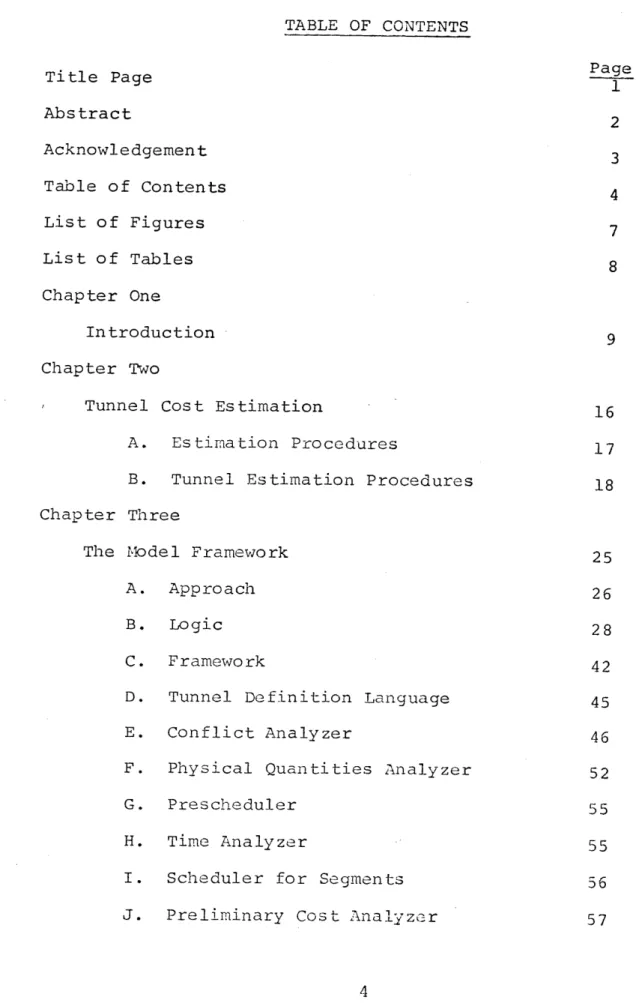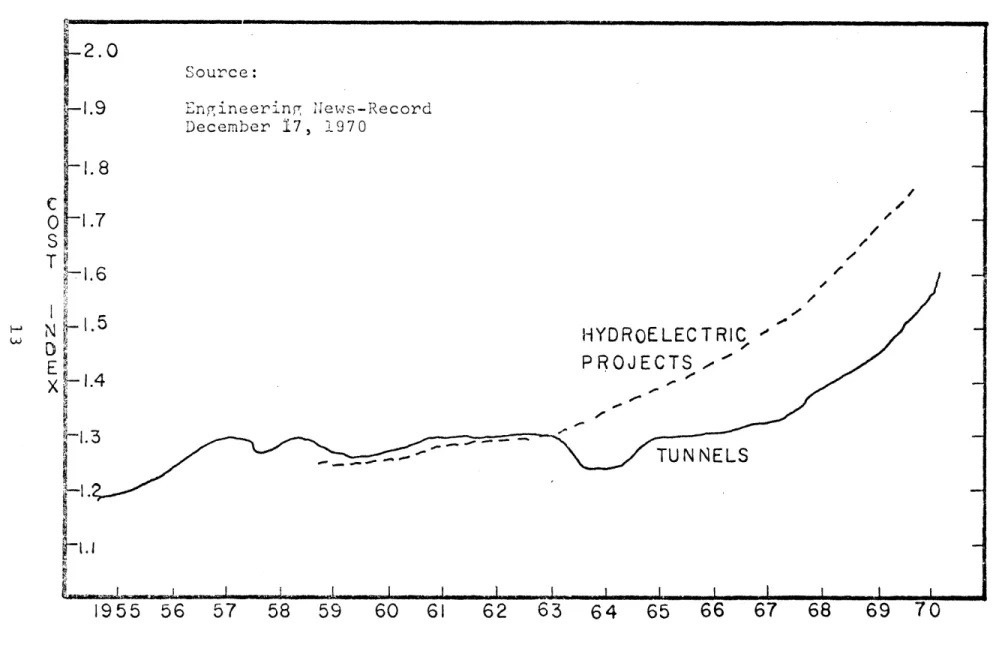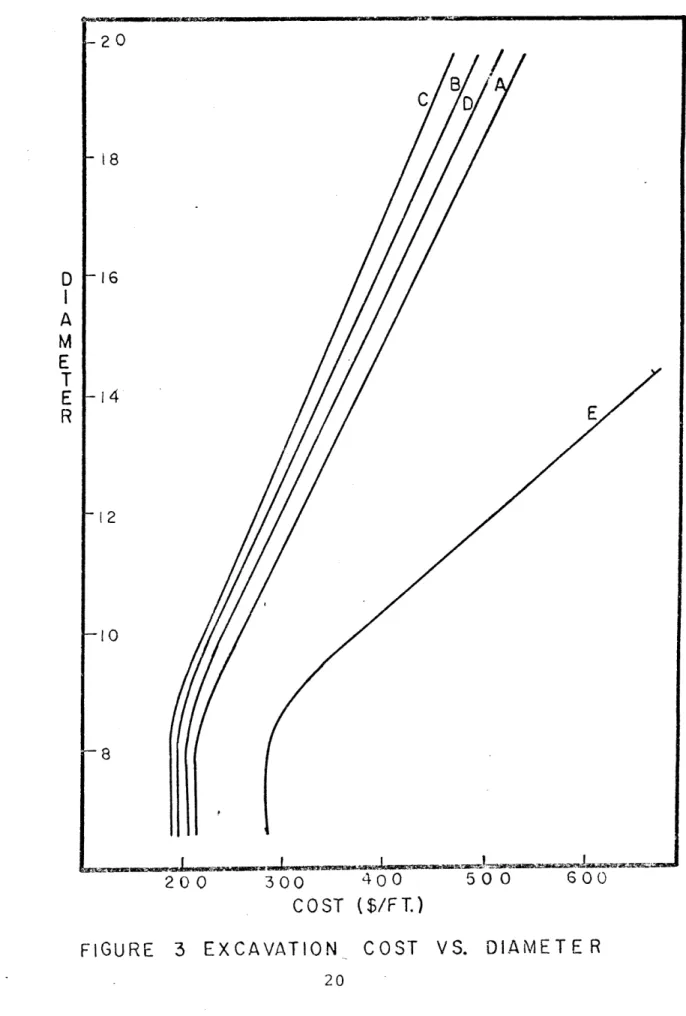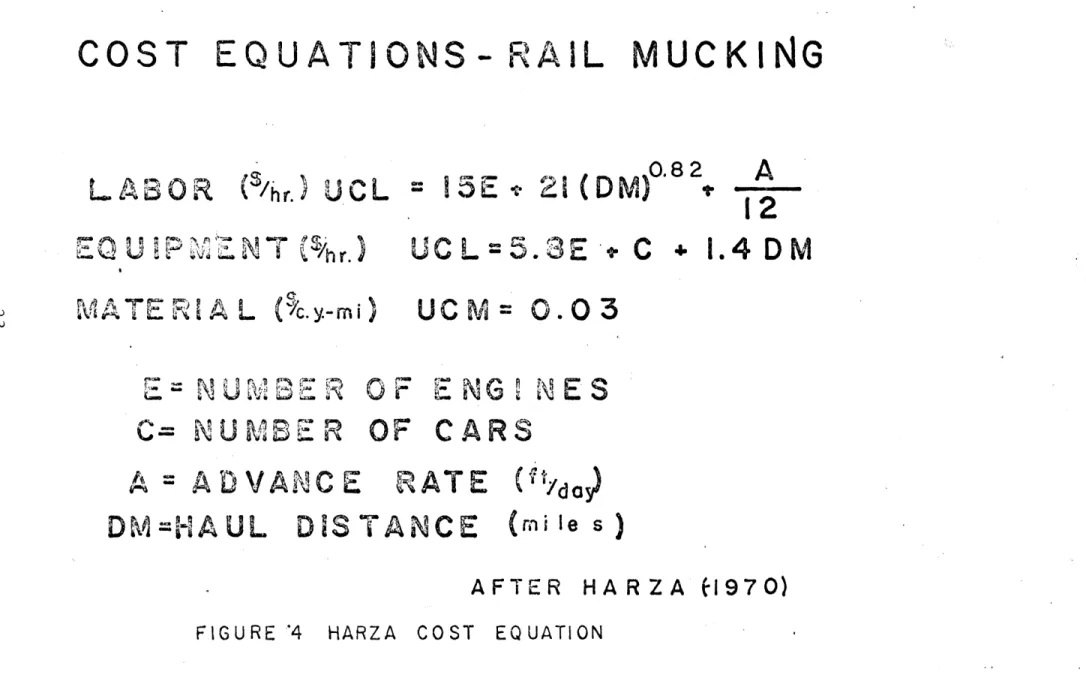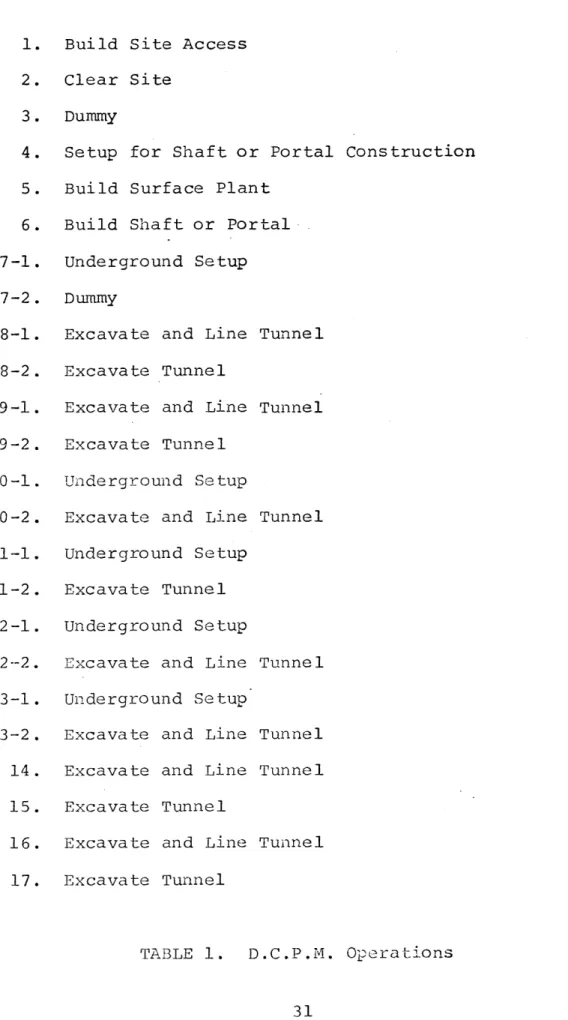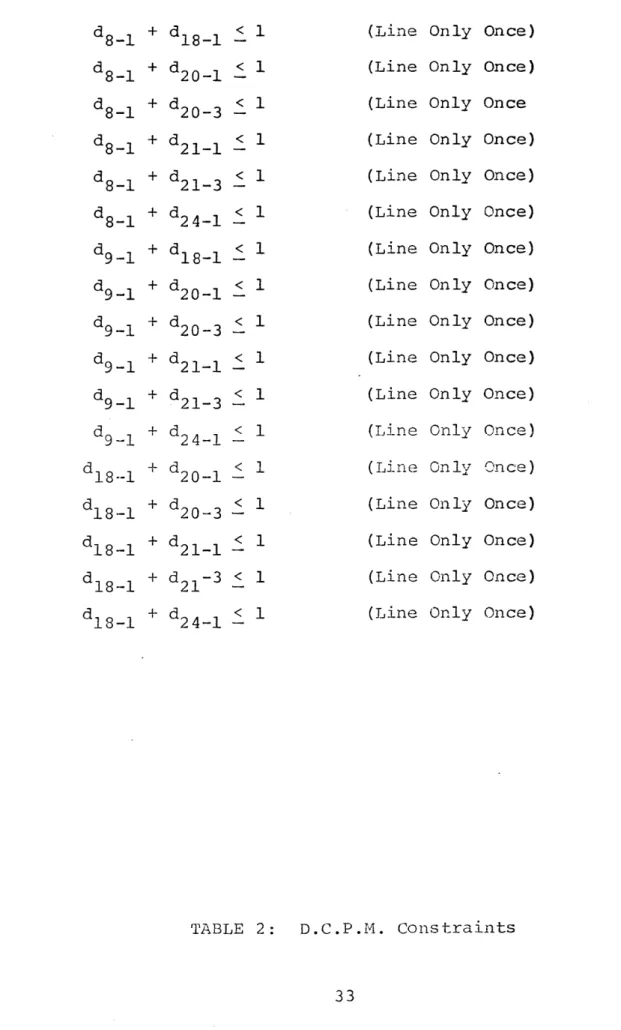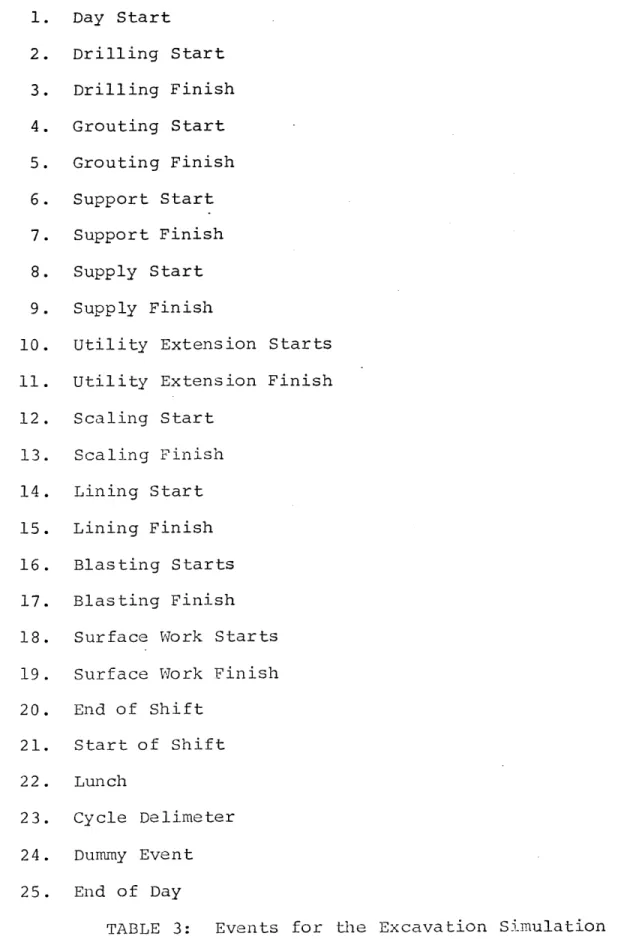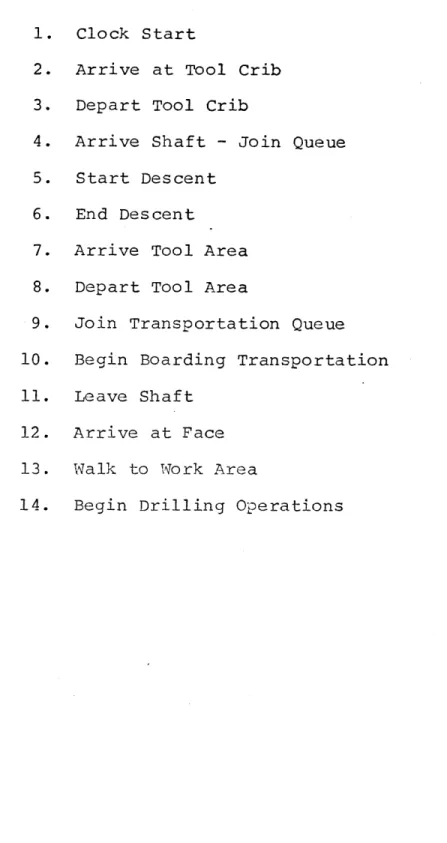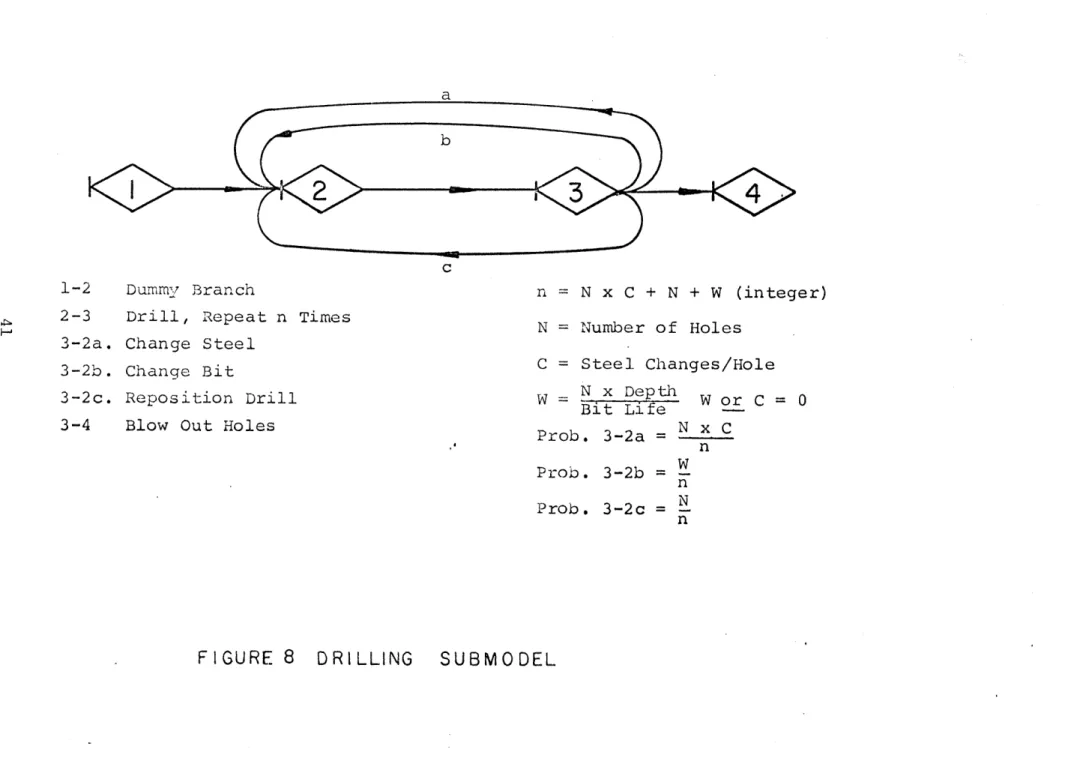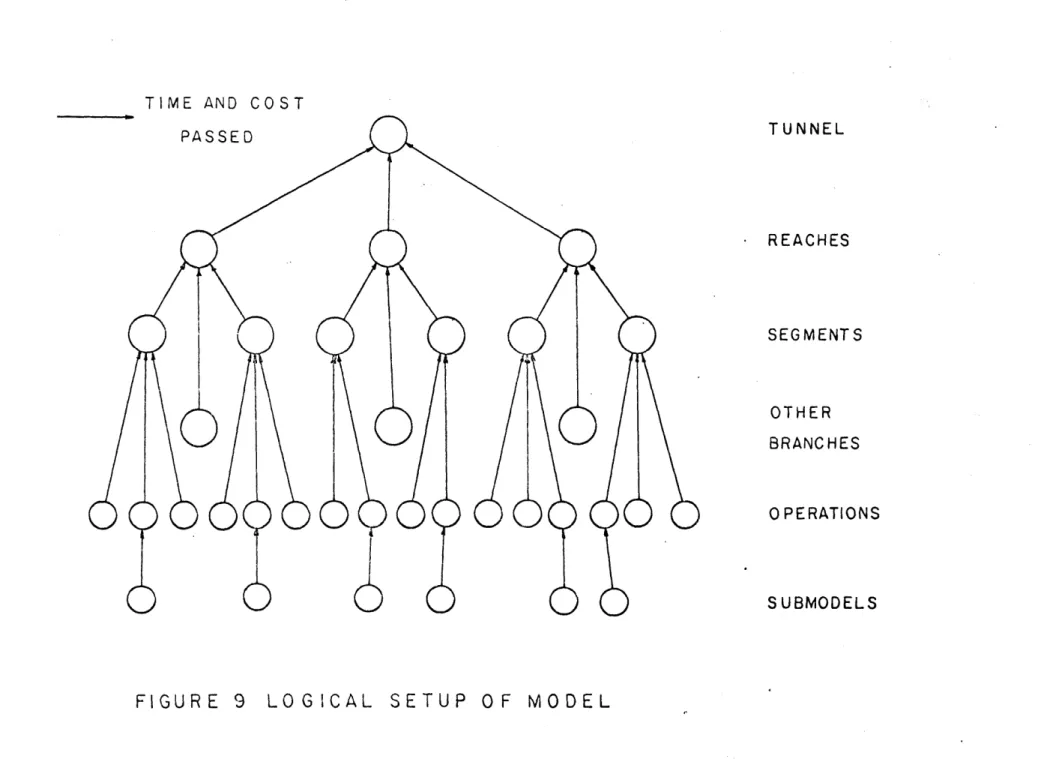A COMPUTER MODEL FOR TUNNELING COSTS by
Thomas J. Lamb
S.B., Massachusetts Institute of Technology 1969
Submitted in partial fulfillment of the requirements for the degree of
Master of Science at the
Massachusetts Institute of Technology June 1971
Signature of Author. .. ...
Department of Civil Engineering, May 14, 1971 Certified by . . . . . . . . . . . . . . . . . . . . . . . Thesis Supervisor Accepted by . . . . . . . . . . . . . . . . . . . . . . .
ABSTRACT
A COMPUTER MODEL FOR TUNNELING COSTS by
THOMAS JAMES LAMB
Submitted to the Department of Civil Engineering on May 14, 1971, in partial fulfillment of the requirements for the degree of Master of Science.
Tunnels are being used more and more to solve the press-ing environmental and social problems of our society. They are very expensive, but little is known concerning the
influence of various factors upon the cost. An approach has been developed which uses a computer to model tunnel
con-struction. This model is detailed enough to permit cost estimation, sensitivity analysis, and the evaluation of new construction techniques.
The model consists of four stages: setting up the data, determining the cost of each segment, determining the cost of each reach, and finding the minimum cost. Event simula-tion is used to model the excavasimula-tion process. Simulation or network techniques are used to model particular operations.
Decision C.P.M. is used to find the cost of the reach. The first stage has been implemented on the MULTICS time sharing system at M.I.T. It is written in the PL/1 programming
language.
Thesis Supervisor: Professor Fred Moavenzadeh Associate Professor of Civil Engineering Title:
ACKNOWLEDGEM4ENT
I wish to thank my advisor, Professor Fred Moavenzadeh, for his constant encouragement of this work and much helpful advice. Professor Frederick J. McGarry and Professor Ronald C. Hirschfeld of M.I.T. and Mr. Frank Wheby of the Harza Engineering Company also provided many helpful discussions.
Special thanks is due to Christopher Herot who wrote the programs and whose knowledge of programming was an invaluable aid. Debbie Allinson provided much needed
encouragement and moral support. Rosemary Dujsik typed the thesis quickly and accurately.
Many other persons, too numerous to identify, lent encouragement and provided information, for which I am very grateful.
TABLE OF CONTENTS Title Page Abstract Acknowledgement Table of Contents List of Figures List of Tables Chapter One Introduction Chapter Two
Tunnel Cost Estimation
A. Estimation Procedures
B. Tunnel Estimation Procedures Chapter Three
The Model Framework A. Approach B. Logic C. Framework
D. Tunnel Definition Language E. Conflict Analyzer
F. Physical Quantities Analyzer G. Prescheduler
H. Time Analyzer
I. Scheduler for Segments J. Preliminary Cost Analyzer
Page 1 2 3 4 7 8 9 16 17 18 25 26 28 42 45 46 52 55 55 56 57
K. Conflict Analyzer 58
L. Main Scheduler 59
M. Unit Cost Calculator 59
N. Cost Analyzer 59
O. Cost Minimizer 60
Chapter Four
Conclusions and Discussion 61
References 65
Appendix A
Tunnel Construction 72
Part I: Components of the Tunneling Cycle 73
A. Excavation 73 B. Mucking 74 C. Support 77 D. Lining 79 E. Groundwater Control 81 F. Ventilation 82 G. Surface Plant 83 H. Safety 84
Part II: Tunnel Costs 86
A. Tunnel Cost Components 86
B. Influence of Geology and GroundJater 92
C. The Effect of 'eometry 94
D. The Effect of Excavation Method 97
E. The Effect of Mucking Method 98
F. The Effect of Support and Lining Systems 99 5
G. H. I. Appendix B Tunne 1 A. B. C. D. E. F. G. H. I. Appendix C A Cost A. B. C. Appendix D Prograrr A. B.
The Effect of Groundwater and Ventilation Regional Considerations Time Considerations Definition Language Introduction The Program Users Manual
Initiate-Symtab and Mo dify-Symtab Initiate-Methods and Modify-Methods Initiate-Tunnel and tdl Tunnel Example Listing Estimation Program Description Structure
Output and Listing
for Powder Calculations Example Listing 100 101
102
103
103 105 105 106 108 110 112 123 155 156 157 160 217 220 222LIST OF FIGURES
Figure 1: Projected Tunneling Activity 11 Figure 2: Cost Increases in Tunnels and Hydroelectric 13
Projects
Figure 3: Excavation Cost vs. Diameter 20
Figure 4: Harza Cost Equation 23
Figure 5: Bledsoe's Approach 24
Figure 6: Network for Reach Construction 30 Figure 7: Model for the Drilling Event 40
Figure 8: Drilling Submodel 41
Figure 9. Logical Setup of Model 43
Figure 10. Flow Chart of Proposed Program 44 Figure 11. Tunnel Definition Language Example 49
LIST OF TABLES
Page
Table 1: D.C.P.M. Operations 31
Table 2: D.C.P.M. Constraints 33
Table 3: Events for the Excavation Simulation 34
Table 4: Drilling Crew 36
Table 5: Events in Simulation for Drilling Crew 37 Table 6: Events in Simulation for Surface Crew 38
Table 7: Construction Methods 47
Table 8: Conflict Criteria 48
CHAPTER ONE In troduc tion
INTRODUCTION
The space beneath our cities can be used for transpor-tation, service, and possibly living space. The interior of the earth has been utilized to a very limited extent for subways, deep basements, and depressed highways, but the potential exists for a much greater utilization of under-ground space. It is expected that efforts to better utilize
this space will be substantially increased during the next several years. The facilities to provide water and power services frequently make use of underground chambers or con-duits, and will do so even more in the future, to avoid
surface congestion.
Several studies have been made in an attempt to pre-dict future tunneling activity. Figure 1 shows the results of two such studies, one by the Committee on Rapid Excavation of the National Research Council (1968) and one by the U.S. delegation to the Organization for Economic Cooperation and Development (1970). The two studies indicate a growth in demand of more than 100% every ten years, but the absolute predicted demand, in dollars, varies widely. This figure
indicates that demand will be large, will grow rapidly, and is extrodinarily difficult to predict. In another study, Operations Research, Inc. (Lago et al, 1967) indicated that the demand for tunnels is a function of their cost.
Even if demand could be predicted, the costs associ-ated with these tunnels would not be well known. They cannot
OECD
rYOU-CW;( T~-L~ L '-CI
~
4.~~p PI~l~-r a~sc~C
a- - I.- - II~--) L~~lY C~i-~--.-
- -1960-19700-1970-1980
OECD
COMM. ON RAPID EXCAVATION 19 80-1990FIGURE
I
PROJECT
ED
COMM. ON RAPID EXCAVATION r'-5
.4
30 20-101,~,,
I 6TUNNELING
ACTIVITY
be extrapolated using a
cost
index such as that given in
Engineering News-Record.
Figure 2 shows past costs of tunnels
and of hydroelectric projects, which are more or less typical
of heavy construction. Tunnel costs seem at present to be
increasing less rapidly than costs for heavy construction
in general.
If this trend continues, tunneling will become
more and more attractive when compared with surface
construc-tion.
The use of a cost index implies a base cost to which
the index can be applied, and this cost must be estimated.
Until very recently, satisfactory methods for predicting
the cost of a tunnel quickly and accurately did not exist,
and producing the base estimate was a major task. Even very careful estimates, such as a contractors bidding estimate, or the engineers estimate, frequently disagree with each other and with the final cost. There are two major reasons for this. The cost of a tunnel is highly dependent upon the geologic conditions encountered, and geologic conditions are rarely well known. It is desirable to estimate the cost of a tunnel for several geologies, so that a range of costs is available and construction strategies for use in emergencies can be worked out, but this is rarely done, because of the
time required to make accurate estimates.
The second reason for the inaccuracy of tunnel cost estimates in the dependence of cost upon the method used and upon the interactions between the operations occuring
under-2.0
Source:
1.9 En7,ineerin, News-RecordDecember
17,
1970
C/
0 1.7
"
T
1.6
N
HYDROELECTRIC
E
PROJECTS
,
X 1.
4...
TUNNELS
1955
56
57
58
59
60
61
62
63
64
65
66
67
68
69
70
2
COST INCREASES
IN
TUNNELS
ground. The various components of a tunnel (excavation, muck-ing, support, etc.) are usually given separate costs, but
this is somewhat misleading, since they are really inter-dependent. Alternate construction methods are rarely inves-tigated in detail, and the simplified estimating procedures that are used to investigate alternatives can be inaccurate. Appendix A discusses the tunneling process and the factors which influence cost.
Considerable work is being done in an attempt to deter-mine geologic conditions with more accuracy. Research is also in progress evaluating new construction methods. Some procedure is needed to evaluate these new methods of exca-vation with respect to cost. Also, an improved method of estimating costs is needed, so that costs can be determined more rapidly and with greater accuracy. A computer program which can estimate costs in great detail for various con-struction methods fits these requirements. The program should take into account what is happening underground
minute by minute. The large number of calculations necessary can be done quickly and accurately, so more alternatives
can be investigated.
It is the purpose of this thesis to develop the logic for such a program. A complete implementation of the
detailed approach outlined herein is beyond the scope of this work, but a considerably more limited version, which illustrates the basic approach taken, has been implemented.
Suggestions are presented for the complete implementation, but the details are lacking. The program has been written in PL/1 on the MULTICS system (time sharing) at M.I.T. This
language and system were used because of the relative ease with which they can handle large quantities of data.
CHAPTER TWO Tunnel Cost Estimation
TUNNEL COST ESTIMATION
Estimation Procedures
There are several methods of cost estimation currently in use, and probably as many variations as there are estima-tors. Three basic approaches will be discussed below. Each has its advantages and disadvantages, and which is the "best" depends upon the purpose for which the estimate is made.
Costs are sometimes collected from previous projects and used as a basis for predicting future costs, often
coupled with a cost index. In order for the estimate to be reasonable, the project to be estimated must closely match the projects from which data is obtained, both i.n design and in construction procedure. This type of estimate is fairly simple to make and does not require a detailed knowledge of design or construction on the part of the estimator. Thus, it is useful for preliminary planning. It is easy for an estimate of this type to be misleading, however, especially if significantly different construction techniques are used.
The second type of estimate is based upon unit costs. These can be either calculated, based upon the operations necessary to do the job, or they can be based on costs from previous jobs. This type of es-timate requires more knowledge
of design and construction than the previous type, and takes longer to do, but it is more detailed and more reliable. The so-called "law of averages" usually insures that even if the exact construction or design details are not known, the
total cost will be reasonable. This is the type of estimate used most often in feasibility studies. The reliability of this type of estimate is quite variable, depending upon how the unit costs are obtained.
The third type of estimate is a very detailed calculation based upon the exact knowledge of how an operation is to be
performed, who is to do it, how long it will take, and the labor, equipment, and material prices. This type of esti-mate requires a detailed knowledge of the project design and elaborate preplanning of the work. Hence, it is a difficult and time consuming type of estimate to make. On the other hand, it is probably the most reliable estimate possible. The basic cost data (wages and equipment and material prices) are fairly easy to obtain, but productivity of men and
machines is difficult to evaluate. New techniques can be incorporated into the estimate if their characteristics are known. Deathridge (1965) and Parker (1970) give excellent treatments of this type of estimate.
Contractors often use this type of estimate on big jobs, since it is rather easy to adapt to C.P.M. or PERT scheduling techniques. This method has the additional advantage of
specifying the details of each operation, so that if costs are excessive, the operations departing from assumptions can be pinpointed and perhaps rectified.
Tunnel Estimation Procedures
the estimation of tunnel costs was puiblished by the California Department of Water Resources (1959). The Department was
concerned with various alternative aqueduct systems to serve southern California, and they developed a systematic cost estimation procedure for planning purposes.
Using tunnel diameter and geologic conditions as their basic variables, the Department evaluated many previous
tunnel jobs and constructed charts giving the costs of the various components versus these variables. These charts provide a quick and fairly accurate estimate of the cost of constructing a non-pressure water tunnel in California
in 1957. This procedure is a vast improvement over a completely separate estimate for each tunnel. It is also
instructive to see graphically how various factors influence cost. Figure 3 shows one of their charts, plotting cost vs. diameter for various geologies.
The procedure developed in California has many draw-backs which make it difficult to use in general. It gives accurate results only for a specific area of the U.S. at a specific time. Hirschfeld (1965) has updated the costs in this report to 1964 using the Engineering News-Record Cost Index, but the applicability of this Index to tuninels is somewhat questionable, and no provision is made for costs
in different regions of the country. It may well be easier to derive new cost curves than to compute an accurate cost index.
20
B
CD
18
D
-16
A
M
E
T
E
-14
R
E
12
10
8
200
300
400
500
600
COST (S/FT.)
FIGURE
3 EXCAVATION
COST VS. DIAMETER
The California method takes account only of drilled and blasted tunnels, driven from portals. Extensive
additional computations are required if tunneling machines are used or if the tunnel is driven from a shaft. Also, the design of the supports and lining and the advance rates are fixed, and there is no easy way to incorporate different designs into the charts. In spite of these drawbacks, the California charts are useful in obtaining a first approx-imation of tunnel costs, if care is taken in projecting prices to today's levels.
More recently, (1968, 1970) the Harza Engineering Company has developed cost estimation procedures for the U.S. Department of Transportation. The aim of these studies was to provide cost estimates for the tunnels in a high
speed rail transportation system in the Northeast Corridor. Their first effort, (March, 1968) was set up much like the California estimation procedure, except that the breakdown into components was a bit different and tunneling machines were considered. Their geological classification system is difficult to use and the tunnel design is fixed. The prices given are for Chicago in 1967, and no criteria are given for modification for different times and places.
The second effort of this company utilized a computer to estimate the costs. The computer program is considerably more flexible than the previous procedure, and various
combinations of excavation, mucking, support, and lining
methods can be evaluated. The geological classification
system is much better, and attempts have been made to extend the estimates to other parts of the country.
The equations which the computer uses to estimate costs (see Figure 4) were derived by estimating costs for various cases (in detail), deciding what factors influence the cost, and plotting these costs versus the factors to obtain a cost equation. The design details are built in, as are the
details of all construction procedures. Nevertheless, this program represents a great improvement over previous pro-cedures.
There are many other cost estimation procedures used by individuals and agencies which have not been published. It is probably safe to say that each estimator has his own more or less systematic procedure. These procedures are usually quite detailed, cumbersome, and difficult to ex-plain. Bledsoe (1970) suggests that a much better approach would be to calculate the cost of a tunnel by knowing what is happening at the face in great detail and using a computer to calculate the cost directly. This "model" of underground construction could then be modified, and the effect upon cost noted.
Bledsoe's procedure is outlined in Figure 5. The
approach suggested in the next chapter is similar to Bledsoe's approach in that both consider the tunneling operation in great detail, but the techniques used are quite different.
COST EQUATIONS- RAIL MUCKING
LABOR
(S/hr.) UCL
=
15E
0.
82
A
21(DM)
12
12
E0,4U
'!P
Ago".
MATE iA L
('c..-mi)
UCL=5.3E
-UCM= 0.03
C * I.4DM
C= NiUMER
A = ADVAACE
N ES
OF CARS
RATE
("t/do
DM=HAUL
DISTANCE
(mile
s
)
AFTER HARZA
FIGURE
A4
HARZA
COST
EQUATION
CHAPTER THREE The Model Framework
Tunnel construction today is largely a trial and error process. Very little analysis of the actual construction process has been performed, the excuse usually being that geology is too variable. A computer program capable of analyzing construction should be fast enough to calculate results for various geologic conditions and overcome this difficulty. The framework for such a model is presented in this chapter. The goals of such a program are first dis-cussed and the approach taken to meet these goals is out-lined. The logic of the program and the method of analysis is then described. Finally, a framework for implementation and partial results are presented.
Approach
Three goals should be met by the program:
1) Accurate Cost Estimation.
2) The ability to perform sensitivity analysis and to evaluate new construction methods. 3) Convenience and ease of use.
These goals determined the approach taken.
Cost estimates which are reasonably accurate can be obtained by using COHART (the program developed by Harza Engineering) or the modification of this program presented in Appendix B. If construction cost is all that is desired, and if current methods are to be used, it is not necessary to use a more detailed program. A detailed program will
give accurate cost estimates also, but improvement will be marginal.
A detailed approach is necessary for sensitivity analy-sis. It is impossible to determine the effect of, for
example, drilling crew size upon cost unless the effect of a change in drilling time upon the mucking or support
operations can be specified. The relation is not simple, because crews must be transported to the face, work areas are crowded and operations interfere, and there are many alternate ways of scheduling the operations underground. It is extremely simplistic to look at tunnel construction as a collection of independent events, and any sensitivity analysis based upon this assumption may be misleading. Miuch the same thing can be said for the evaluation of a new
construction technique; interactions cannot be ignored. A detailed approach has the advantage that the cost information required (wages, equipment operating costs, and material costs) is much easier to obtain than the cost per foot for some operation. Cost per foot depends upon geology, geometry, method used, schedule, equipment, etc., and the relationship is anything but clear. (It should be noted that a cost model capable of sensitivity analysis can help clarify these relationships).
Defining exactly what is happening during construction is very difficult because activities vary from tunnel to tunnel. The construction details are set by the contractor based
largely upon his feeling for what is most effective. A de-tailed program must either contain assumptions as to the
schedule of allow the user to specify it. The most convenient way for a user to specify the schedule is through the use of
time sharing. With this type of system, the user can inter-act with the model and modify his assumptions based upon results.
The amount of time a given operation takes is not well defined. It is possible to derive time distributions for certain operations, either based upon past data or assumed, and use simulation to determine the time for the entire
process. Simulation can also be used when productivities or efficiencies are not known exactly
A detailed program should model the tunnel construction process operation by operation, determining progress, the amount of time each man works, and the amount of time each piece of equipment is in operation. A full day (three shifts) must be modeled to take care of variations in scheduling and transportation. The user must define how things are to be done. Logic
Tunnel construction must be analyzed at three levels of detail. The reach level is the most general level. A reach is that portion of the tunnel excavated from one shaft or portal (c.f., Harza, 1970). The cost of the reach includes the cost of tunnel construction, the cost of the plant and surface equipment, the cost of the shaft or portal, and
overhead, profit, and interest. The reach can be modeled
using a decision C.P.M. network as shown in Figure 6. Table 1 lists the operations and Table 2 lists the constraints.
This network can be solved using integer linear programming (Crowston & Thompson, 1965).
Costs and times for each reach operation can be determined by modeling it. Clearing operations, shaft construction,
and finishing operations will not be considered further, but they could be modeled in a manner similar to excavation. The determination of excavation cost requires that the seg-ments within the reach be modeled.
A segment is a portion of the tunnel in which every-thing is constant. After a certain number of segments have been constructed, some of the plant may be moved underground.
If the cost of construction is computed both with the move and without the move, the D.C.P.M. reach network will tell which is the best solution.
Segment construction can be modeled using event simula-tion. Several time periods are of interest. The cycle is basic to tunneling and must be kept in mind. A shift must be modeled in order to determine transportation costs. A day, or three shifts, may have to be modeled, depending upon scheduling. Table 3 lists the events which might be used in a simulation of excavation. The events can be ordered by
the user. Defining the sequence of events will determine the schedule underground.
1. Build Site Access 2. Clear Site
3. Dummy
4. Setup for Shaft or Portal Construction 5. Build Surface Plant
6. Build Shaft or Portal 7-1. Underground Setup 7-2. Dummy
8-1. Excavate and Line Tunnel 8-2. Excavate Tunnel
9-1. Excavate and Line Tunnel 9-2. Excavate Tunnel
10-1. Underground Setup
10-2. Excavate and Line Tunnel 11-1. Underground Setup
11-2. Excavate Tunnel 12-1. Underground Setup
12-2. Excavate and Line Tunnel 13-1. Underground Setup
13-2. Excavate and Line Tunnel 14. Excavate and Line Tunnel 15. Excavate Tunnel
16. Excavate and Line Tunnel 17. Excavate Tunnel
18-1. Line Tunnel 18-2. Dummy
19-1. Cleanup
19-2. Finish Shaft or Portal 19-3. Dummy
20-1. Finish Shaft or Portal 20-2. Finish Shaft or Portal 20-3. Line Tunnel
21-1. Line Tunnel 21-2. Cleanup 21-3. Cleanup
22. Finish Shaft or Portal 23. Cleanup
24-1. Line Tunnel 24-2. Dummy
25. Line Tunnel
26. Finish Shaft or Portal 27. Cleanup
28. Line Tunnel 29. Final Cleanup
d8-1 + d18-1 < 1 (Line Only Once) d8- 1 + d20-1 < 1 (Line Only Once)
d8-1 + d20-3 < 1 (Line Only Once d8-1 + d21-1 < 1 (Line Only Once) d8-1 + d21-3 < 1 (Line Only Once) d8- 1 + d24-1 < 1 (Line Only Once)
d + d < 1 (Line Only Once) 98-1 201-3
-d9-
1+ d21-1 < 1
(Line Only Once)
d + d < 1 (Line Only Once)
9-1 21-3
d 9-1 + d + d218-1 < 1 (Line Only Once)(Line Only Once)
dl8-
1+ d20_l < 1
(Line Only Once)
d + d < 1 (Line Only Once)
18-1 20-1 < 1 (Line Only Once) d 181 + d 21-3 < 1 (Line Only Once) d 8-1 + d 24-1 < 1 (Line Only Once)
TABLE 2: D.C.P.M. Constraints TABLE 2: D.C.P.1. Constraints
1. Day Start 2. Drilling Start 3. Drilling Finish 4. Grouting Start 5. Grouting Finish 6. Support Start 7. Support Finish 8. Supply Start 9. Supply Finish
10. Utility Extension Starts 11. Utility Extension Finish 12. Scaling Start 13. Scaling Finish 14. Lining Start 15. Lining Finish 16. Blasting Starts 17. Blasting Finish 18. Surface Work Starts 19. Surface Work Finish 20. End of Shift 21. Start of Shift 22. Lunch 23. Cycle Delimeter 24. Dummy Event 25. End of Day
Each event in Table 3 represents the start or comple-tion of an operacomple-tion. Each operation can in turn be modeled by a simulation, and the time of occurrence of the start of the next operation or the finish of the operation in question can be determined. The solution of the main simulation will give construction time. (Cost is determined by the operation simulations). The schedule can be changed and the simula-tion run again to determine the sensitivity of cost and completion time to scheduling.
Interactions between operations can be modeled by inter-actions among the operations simulations. For this purpose, and for cost computations, the groups of men performing
different operations must be separated. Crews can be defined for this purpose. Table 4 lists the members of the drilling crew. The user must specify the size and composition of each crew and their wages. The actions of each crew can be simulated separately, with the simulations interacting. An example will clarify this.
The day start event will initiate the two sequences of events listed in Tables 5 and 6. (Additional simulations will be initiated for the other crews). The drilling crew cannot descend the shaft until the surface crew has readied the hoist. There may be additional interactions with other crews. The user must specify these relationships. Simula-tion languages such as SIMSCRIPT II make this relatively easy.
1 Foreman N Drillers N Helpers 1 Supply Man
NOTE: Crew Size must be Defined by the User
1. Clock Start
2. Arrive at Tool Crib 3. Depart Tool Crib
4. Arrive Shaft - Join Queue 5. Start Descent
6. End Descent
7. Arrive Tool Area 8. Depart Tool Area
9. Join Transportation Queue 10. Begin Boarding Transportation 11. Leave Shaft
12. Arrive at Face 13. Walk to Work Area
14. Begin Drilling Operations
Clock Start Open Crib
Hoist Ready
Ventilation System Started Compressors Started
Generators Started
Begin Readying Muck Disposal System Begin Startup of Concrete Batch Plant Begin Surface Operation Model
Each event in Tables 5 and 6 can be modeled in as much detail as desired. Sufficient accuracy can probably be obtained by simply specifying a time distribution for each event. Costs for the men can be determined by multiplying
times by wages. Time can be further broken down into produc-tive time and lost time if desired. The equipment usage time can also be collected and equipment cost calculated.
Event 14 in Table 5 triggers the start of the drilling event in Table 3. If actual drilling is uneffected by
other events, techniques more efficient than simulation can be used. Figure 7 shows a GERT (Graphical Evaluation and
Review Technique, Pritsker, 1966) network which can be used to simulate drilling. Programs exist for the solution of GERT networks. The solution of this network will give the time and cost for drilling. For each branch, crew wages and equipment operating costs must be specified. Material
cost (bits and power) can be computed separately. The
probability of completing the drilling on schedule can also be obtained from the GERT network.
It may be desirable to model certain branches of this network in more detail. Figure 8 shows a submodel for the drill branch. This GERT network can be solved for the time and cost of actual drilling. The user must specify time and cost information for each branch and must supply the parameters used to determine n.
Advance Sliding Floor Lay Track Bring up Drills Bring up Jumbo Bring up Jumbo Dummy Branch Bring up Drills Dummy Branch Position Jumbo Position Drills Connect Utilities Drill Disconnect Utilities
One Branch Chosen by User
One Branch Chosen by User
One Branch Chosen by User
MIODEL
FOR THE DRILLING EVENT
1-2a. 1-2b. 1-2c. I-2d. 2-3a. 2-3b. 2-4a 2-4b 3-4 4-5 5-66-7
7-8
FIGURE 7
Dummy Branch
2-3 Drill, Repeat n Times
3-2a. Change Steel 3-2b. Change Bit
3-2c. Reposition Drill
3-4 Blow Out Holes
n = N x C + N + W (integer)
N = Number of Holes
C = Steel Changes/Hole W = N x Depth -Bit ... .Lifet --- , , W or C -- 0
Prob. 3-2a Nx C n Prob. 32b -n Prob. 3-2c = n
FIGURE
8
DRILLING
SUBMODEL
with it. Where interactions can be ignored, efficient com-putational methods such as GERT can be used. Where events interact, event simulation is probably a better procedure. Interactions and sequences must be defined by the user. Once the main simulation of excavation has been constructed it should be run several times to obtain a reasonable cost-advance relationship. The simulations can be constructed to reflect delays due to unexpected geologic conditions or equipment breakdowns by adding a breakdown or delay event and specifying its interactions with other events. In
addition, more detail can be added to the analysis. Running time on the computer may be a limitation in this respect. Figure 9 summarizes the logic for tunnel construction modeling. Several reach models can be combined to form a model for the entire tunnel, as shown here.
The Framework
A framework for the implementation of the model has been developed and is shown in Figure 10. Four stages are used: defining the tunnel, modeling segment construction, and cost minimization.
The first stage consists of the tunnel definition language and the conflict analyzer. These two processors define the geologic and geometric properties of the tunnel and the construction methods to be used. The tunnel
definition language has been implemented on the Multics time sharing system at M.I.T. It is written in the PL/l
TIME AND COST
TUNNEL
REACHES
SEGMENTS
OTHER
BRANCHES
OPERATIONS
SUBMODELS
METO0 S
LL
0..e ooe5U
Ue
TUNNEL~
0OFLC
0HSCLTM
REACH
EQUIPMENT
CONSTRUCTION
COST AND
DESCRIPTION
DEPRECIATION
D ATA
PLANT AND
OVERHEAD
UNIT COST
SETUP
EQUIPMENT
PROFIT
DATA
TIMES
DEFINITIONS
EXTERNALS
RETURN
PRELIMINARY
FOR
CONFLICT
MAIN
UNIT
COST
COST
COST
NEXT METHOD
ANALYZER
SCHEDULER
CALCULATOR
ANALYZER
ANALYZER
OR NEXT
SEGMENT
iEDULE
COST
FOR
METIH )DS UO ED
WCRK SCHEDULE
Cos
N E W' J N I
EACH
EACH METHOD
I % E AC H
I N
REACH
COSTS FOR
f:O f
.THOD
AND
SEGMENT OF
FOR EACH
E Q U I PM E N T
C 0 M H I
3M E N T
EACH SEGMENT
A REACH
COMBINATION
0 F %l
E
programming language. A listing and users manual is pre-sented in Appendix C.
Tunnel Definition Language
The tunnel definition language consists of 6 programs: initiate-tunnel, initiate-symtab, initiate-methods, modify-methods, modify-symtab, and tdl. Initiate-tunnel names the tunnel, defines the maximum number of reaches, shafts, and segments in the tunnel, and sets up a data structure to hold geologic, geometric, and method data for each segment. tdl can be called either automatically by initiate-tunnel or, if the information about an existing tunnel is to be changed, directly by the user. tdl asks for the shaft where each reach originates and its destination shaft. It also requests names for the segments in each reach and geologic and
geometric information for each segment. The number of shafts, reaches, and segments named in tdl can be less than the
number specified in initiate-tunnel.
Initiate-symtab tells the computer where the symbol table is. The symbol table contains the names given to each item of geologic and geometric data and its location in the array where it is stored. Modify-symtab can be used to add or delete names.
Initiate-methods identifies a table of methods to the computer. The user can then describe what construction methods he wants to consider through the use of modify-methods. Methods which might be considered are listed in
Table 7. Initiate-methods also identifies a table of
criteria used by the conflict analyzer to eliminate methods. Table 8 lists some sample criteria. Modify-methods can be used to add, delete, of change criteria. Figure 11 shows an example of the use of the tunnel definition language. For more details, refer to Appendix C.
The geologic information needed is R.Q.D. (see Deere et al, 1969), rock compressive strength (psi), initial
groundwater inflow (gallons per minute at the face), steady state groundwater inflow (g.p.m./foot), and rock temperature. R.Q.D. or rock strength may be specified as a probability distribution with a given mean and standard deviation. The geologic information must be obtained from a geologic
exploration of the tunnel site. Great accuracy cannot be expected.
Geometric information required is tunnel size and shape, slope, depth, and length. These parameters are determined by the tunnel design. The size and shape are specified by a radius and center co-ordinate for circular tunnels and by four co-ordinates and four radii for non-circular tunnels. Refer to Figure 12. A radius of zero indicates a flat surface. The size specified is finished size. The use of this type of specification permits any size or shape of tunnel to be analyzed.
Conflict Analyzer
Excavation Methods
Drill and Blast--Conventional Heading and Bench
Multiple Drift Mechanical Mole Support Methods Steel Supports Rock Bolts Shotcrete or Gunnite None Grouting Methods Pregrouting Chemical Concrete Grouting Chemical Concrete Pumping Pumps No Pumps Lining Methods None Concrete Sho tcre te Mucking Methods Electric Train Diesel Train Electric Truck Diesel Truck Belt Conveyor
I. Geology
if strength > 32,000 psi, mole eliminated if RQD < 90, some support necessary
if RQD < 25, steel sets necessary II. Groundwater
if sustained inflow > 15 gpm, mole eliminated
if sustained inflow > 0, some grouting or pumping neeed if sustained inflow > 100 gpm, grouting needed
if sustained inflow > 500 gpm, pumps needed also if initial inflow < 1000 gpm, no pregrouting if initial inflow > 50 gpm, mole eliminated if sustained (after grouting) > 5 gpm, lining must be used
III. Geometry
if shape not circular, mole eliminated
if diameter 15', truck mucking eliminated IV. Method
if drill and blast used, no conveyor mucking if pregrouting used, eliminate mole
V. Combinations
if RQD > 50, and if diameter < 15', eliminate heading and bench
if ROD > 25, and if diameter < 15', eliminate multiple drift
if RQD < 95, and if no lining used, support must be used
if RQD < 95, and if no support used, lining must be used
if inflow (sustained) > 25 gpm, and if RQD < 50, grouting required
tunnel test
syritab
found
pdb
found
new tunnel
how many
reaches? 2
how many
shafts?
3
how
many
segments? 4
TUL
specify components:
reach
shaft1
A
porl
i Dor2shaft2
ss
sss
SSSsegments
ab
cd
mod i fy >seg a prompt lmean_rqd 90.0 sigma_rq 10.0 rmeanstrength 25000. s i ria_strength 50u0. x coordinate 1 0.0 x coordinate 2 20.0 x coordinate 3 20.0 xcoordinate 4 0.0 y coordinate 1 20.0 y coordinate 2 20.0 y coordinate 3 0.0 y coordinate_4 0.0 radius 1 20.0 radius 2 0.0 radius _3 0.0 radius 4 U. O length 17500. slope 0.01FIGURE
II
TUNNEL DEFINITION
(SEE
APPENDIX
B
FOR
LANGUAGE EXAMPLE
E XPLANATION)S---depth 3000. init_gwat_ inflow 0.0 sustained gwat_ i 0.0 rock_tremp 50.0 shape 2 rm: sup rb lt shot ;i1: gap none
>rch A
r.m: exc dab mole m: ruck rail trck r: ilin none
iq
r 2122 11.484 50G+234
X
4 ,Y4F IGURE 12
X2 ,Y'
methods which cannot be used because of geologic or geo-metric conditions. The purpose of the conflict analyzer is to reduce the number of computations required. If all
possible combinations of the methods listed in Table 7 were used, almost 2000 cases would have to be considered. This would lead to the use of incredible amounts of computer time.
The conflict analyzer applied criteria similar to those in Table 8 and can reduce substantially the number of cases considered. After the program has been used for a while, the criteria can be made more restrictive and computations further reduced. These changes would be based upon the program results. The conflict analyser has not been
implemented, but it is a fairly simple program.
The second stage of the analysis, the analysis of seg-ments, consists of the physical quantities analyzer, the prescheduler, the time analyzer, the scheduler for segments, and the preliminary cost analyzer with their associated data. This stage designs the tunnel, sets up the construction sche-dule in each segment, and computes the cost of the segment. Physical Quantities Analyzer
The physical quantities analyzer designs the support and lining system for the tunnel, calculates the amount of powder and number of holes needed (if drill and blast
excavation is used), calculates overbreak and quantity of muck, and computes the amount of concrete and steel needed
analysis is presented below, but more sophisticated tech-niques would require more computer time and the improvement
in design to be gained is dubious.
Deere's criteria can be used for design of support and lining (Deere et al, 1969). These criteria give support spacing and weight and lining thickness as a function of R.Q.D. The criteria will be stored in the table of design parameters. Criteria other than Deere's can be used, if it seems desirable. These criteria will be stored in much the same way as the criteria for the conflict analyzer. The physical quantities analyzer will determine spacing and
thickness. Weight can then be computed from geometry. A program has been written to perform powder calcula-tions for blasting, based upon the results of Langefors and Kihlstr6m (1963). This program, presented in Appendix D, determines the length of holes, number of holes, size of
holes, stemming, degree of packing, and quantity of explosive. Some of these parameters, in addition to area and advance
per round, must be specified and the program will compute the others. The physical quantities analyzer can use this program to determine quantities of explosive, primers, and caps. It should be used twice, once for the cut and once for the rest of the face.
The area of the tunnel is equal to
+ R3 (03 -sin 03) + R4 (04-sin 04) ) where D -1 n
On
n2 sin
2R nDn = length of chord n (D1 = [(X 3 -X1) 2 (Y-Y3) 2 1/2
Refer to Figure 12. An effective radius can now be computed and the tunnel calculations performed as if the tunnel were
circular.
Reff = (AREA/7) 1/2
This analysis assumes that the area/effective radius ratio does not change as tunnel size is increased. While not strictly true, this approximation is fairly accurate
for small size changes.
Excavated diameter can be computed once the lining thickness is known.
Dexc = 2(lining thickness + Reff)
True excavated diameter must include overbreak
D ext ext D ex(1 + O.B.)
where
O.B. = % overbreak/100
the quantity of muck produced can be expressed as: (D ext2/4) (1 + B.F.)ext
where B.F. is the bulking factor. It may be desirable to make O.B. and B.F. random variables.
Pres cheduler
The prescheduler sets up the construction sequence in the segment for a given construction method. The method procedure table contains lists of events similar to those
in Table 3 for each construction method. The user must specify the order of the events. The construction descrip-tion input is used to indicate user interacdescrip-tion with the program.
The events in the method procedure table can be identi-fied by refering to the references on tunnel construction. The main events for mole excavation are the same as those in Table 3, but the subevents are quite different. The main events must have linkages to the approximate sub simu-lations for each method. These linkages can be programmed by using pointers.
Time Analyzer
The time analyzer is responsible for assigning times to the events in the lower level simulations, or to the branches of the lower level networks. These networks or simulations are linked to the main events as mentioned above. A few times can be specified as constant, such as "smoke time" or lunch time. Others must be computed. The construc-tion data base contains the informaconstruc-tion needed to compute these times, such as drill penetration rate or equipment
productivity. The user must specify how much and what type of equipment is to be used. With this information and the output of the physical quantities analyzer, times can be assigned to the simulations. In many cases, a time distri-bution rather than a single time should be used. The user must also specify crew size and composition.
The computation of times is relatively straightforward. The time required to descend the shaft, for example, can be computed from shaft depth and hoist speed:
Time (sec) = Depth (Ft) Speed (f.p.s.)
The constants (or distributions) required for the calcula-tions can be obtained from equipment manufacturers. The California Department of Water Resources and the U.S. Bureau of Reclamation also have large stores of data. The con-struction data base and the table of standard times should have values in them. The user can change these values if he prefers his own or wishes to check sensitivity. The
user must also tell which branches, in the case of networks, are to be deleted.
Scheduler for Segments
The entire simulation is set up and times assigned for all events by the time analyzer. The scheduler defines
interactions and solves the simulation. The user must
define the way events interact, as mentioned in the section on logic. Some knowledge of tunnel construction is required
do this. This knowledge can be gained from the references. Many of the relationships are based on common sense.
After interactions have been specified, the segment simu-lation can be solved. Each crew's time is kept in an account, and can be separated into productive time, travel time, and lost time. Equipment operating time is also noted. The simulations must be written to collect these figures. The entire simulation should be run several times so that cost time curves can be developed for use in the reach D.C.P.M. network.
Preliminary Cost Analyzer
The cost analyzer determines the cost of constructing the segment using a given method. The times collected when the segment simulation is solved are multiplied by unit costs and summed to give total cost.
Crew cost is determined by adding up the wage rates of the members of the crew. These wage rates can be obtained from the U.S. Department of Labor. Provision must be made to pay overtime rates for hours worked in excess of 8 (or some other number).
Equipment operating cost is somewhat more difficult to obtain. Some information can be obtained from manufactures or public agencies. Contractors are the best source of
such data, but they are usually reluctant to share it.
Operating costs can be calculated, based upon equipment cost and expected service life (available from manufacturers),
fuel and power consumption, and expected maintenance. The unit cost table should contain equipment operating costs for various pieces of equipment. The user can change the value
if he desires.
When cost has been computed for one construction method in the segment, the program returns to the physical quanti-ties analyzer and begins the analysis of the next method. When all methods have been considered, the next segment is analyzed. Finally, cost and completion time data are
available for all methods in all segments, and the reach can be analyzed.
Conflict Analyzer
It is unlikely that construction methods will vary
radically from segment to segment when the reach is construc-ted. The conflict analyzer forms combinations of segments with compatible (or the same) construction methods and the cost analysis of the reach is done for these co.mbinations. For example, mole tunneling and drill and blast tunneling would not be used in alternating segments. Similarly, the
same mucking method would be used throughout the reach. Computation could be significantly reduced if this conflict analyzer were incorporated into the conflict
analyzer for segments. It is not, in this framework, because the user may be interested in analyzing a particular segment using all methods feasible there, rather than being con-strained by the other segments.
Main Scheduler
The main scheduler sets up and assigns times to the reach D.C.P.M. network. Setup times are the times required to construct the access roads and surface plant. Shaft or portal construction time and cleanup time is included here. The plant and equipment definitions tell what equipment is
included in the surface plant. This information is stored for later use. The reach construction description input
indicates that the user must interact with the program during the setup. He must specify any additional constraints upon the network and can change setup times or plant and equip-ment definitions.
Unit Cost Calculator
The unit cost calculator calculates operating costs for the surface plant. The user must supply the purchase price of the experiment, salvage value, discount rate, fuel and power consumption, etc. The program will convert this into a unit cost, which it will assign to the appropriate branches of the network.
Cost Analyzer
The cost analyzer solves the D.C.P.M. network for lowest cost. Overhead and profit are then added in and total reach cost computed. The externals are costs for branches not analyzed in detail and interest, penalties, or bonuses. These costs will be rather difficult to obtain.
estimates. The best way is to perform a detailed analysis of every branch, but this is probably not feasible. It is also not strictly necessary for sensitivity analysis of construction.
Excavation cost is required for several branches of the D.C.P.M. network shown in Figure 6. It is necessary to return to the segment level to obtain these costs and solve a new excavation simulation for each branch. The user must specify which branch is being computed.
After the network has been solved for one construction method, the main scheduler sets up another network using a different method. This process is continued until all methods have been examined.
Cost Minimizer
The cost minimizer performs the very simple function of finding the lowest cost of those which have been computed and its associated construction method. This can be printed out and the next reach analyzed. Considering each reach separately prevents the user from modeling the transfer of men and resources from one reach to another. Another level of modeling can be added if this is needed.
This is not the only frame work which can be used to implement detailed cost estimation program. It is intended primarily as a guide and may require modification. It
appears to be reasonable, however, both from a logic stand-point and from the standstand-point of programming.
CHAPTER FOUR
Much work remains to be done on the model before conclu-sions can be drawn concerning the tunneling operation.
Several man-years will be necessary to complete development. Conclusions can be drawn concerning the approach taken,
based upon the work done in developing the logic. 1) A very detailed cost model is necessary for
sensitivity analysis of tunneling or for the evaluation of new construction methods. All other methods proposed so far, with the possible exception of Bledsoe's, are neither designed for this purpose nor capable of performing such an analysis. Some insight will undoubtedly be gained from the construction of the model itself. 2) Event simulation is necessary for a large
portion of the model. Very little is
known, quantitatively, about the influence of construction techniques upon cost, and what little is known is based mostly upon empirical evidence. Simulation models can provide data so that more efficient but less general modeling techniques can be used in the future. At this stage of development, it is important to be as general as possible.
3) It is important not to attempt to do too much in one model. Simulation programs take
a long time to run on a computer. The model described in this thesis should not require undue amounts of time, if only excavation is modeled in detail. The conflict analyzers reduce computations. A further reduction may
necessary. Brute force is used for optimization in this model; more sophisticated and efficient techniques can be used when more is known about tunneling.
4) A program using the approach described in
Chapter 3 can be used for construction control, as well as for planning. If conditions are not as anticipated, the model can provide a
revised schedule and cost estimate. Contingency plans can also be prepared with little effort. 5) Time sharing is the best computer environment
for the model. The user must interact with the model in setting up the schedule. In addition, he may want results at any stage of the model and may wish to change one portion based upon the results. A time sharing
system makes this relatively easy to do. Command interperters can be written to mini-mize the amount of programming required of
the user.
6) FORTRAN is a very bad language to use for this model. The limited data handling ability of FORTRAN leads to very severe restrictions. Several languages will be needed for various parts of the model.
7) Special models may be desirable for certain tunnels. A savings of one percent, a very reasonable expectation, on a tunnel costing
tens or hundreds of millions of dollars will pay for a great deal of analysis. Far too
little is done at the present time.
8) This model should be completed as soon as possible, both to check the approach and to
provide a means of analysis. Far too little is known about the factors affecting tunneling cost, and the economic evaluation of new tunneling techniques has been sketchy at best. It is
deplorable that so much money is spent on tunnels without better means of analysis. 9) Better methods of specifying rock properties
are urgently needed. The parameters used in this model do not adequately describe rock's response to tunneling. Models of this sort, although not this particular model, may be useful in this work.
10) The stochastic nature of geology can be
incorporated into the model by defining small segments and generating random numbers for
rock properties. Bledsoe (1970) first suggested this.
ll It should be noted that the framework for reach cost calculation is not as well developed as
the framework for segment cost calculations, This portion of the framework may need revision before implementation can be accomplished.
Nevertheless, it is felt that this framework will provide a useful guide in implementing a program. The logic itself seems to be valid, and the
implementation of the tunnel definition language shows that programming a highly interactive
REFERENCES
References
1) Bledsoe, John D. (1970); "The Development of a Tunnel
System Model."
The Technology and Potential of
Tun-neling,
Papers Presented at the South African
Tunnel-ing Conference, 1970.
N.G.W.
Cook, editor.
2)
California Department of Water Resources (1959);
In-vestigation of Alternative
Aoueduct Systems to Serve
Southern California.
Bulletin No.
78, Appendix C,
September,
1959
(out of print).
3) Cambridge Information Systems Laboratory, (1968);
The Multics PL/1 Language SPecification. General
Electric Company, 1968.
4) Crowston, W., and Thompson, G.L. (1965); Decision CPM:
A Method for Simultaneous Planning, Scheduling, and
Control
of Projects.
Management
Sciences Research
Group, Carnegie Institute
of Technology.
September
9,
1965.
5) Deathridge, G.'.
(1965); Construction Estiat
l ~and
Job Pre-olanninr,
Mc,'awHil
New
York, 1
6) Deere, D.U.
et al.
(1969); Design of Tunnel Liners and
Support
Systems.
Prepared
for
U.S.
Dept. of
Trans-portation, February, 1969. PB 183 799.
7)
Enoineering
News-Record, Dec. 17, 1970,
p.
52.
8)
Hartman,
I.L. (1961); Mine Ventilation and Air
Condi-tioning.
Ronald Press,
New York,
1961,
9)
Harza Engineering
Co.
(1968);
Hih
Sed
Ground
Trans-portation Tunnel Dresin and Cost Data.
Prepared for
U.S. Dept. of Transportation, March, 1968.
PB 178 201.
10) (1970); A Comouter Program for
Esti-mating Costs of Hard Rock Tunneling.
Prepared for
U.S. Dept. of Transportation, May, 1970.
PB 193 272.
11) Hill, G. (1968); "What's Ahead for Tunneling ;Machines?"
Journal of Construction Divisionr ASCE, Vol. 941,
No.
C02, October, 19 8.
12) Hirschfield, R.C.
(1965);
Report on
Hard
Rock
Tunnelin
M.I.T., Cambridge, Mass., Prepared for U.S. Dept. of
13) Lago, A., et al.
(1967); Prclections of AD1ications
and National Benefits of a New Rapid ExcavationTechnology, September 8, 19-7. Prepared for U.S. Bur-eau of Mines. PB 177 784.
14) Langefors, U., and Kihlstrom, B. (1963); The Modern
Technique of Rock Blasting. John Wiley & Sons, New
York, 1963.
15) M.I.T.
(1971); .ULTJIcs
Programmers Manual. PI.T.,
Project Mi'AC.
April
5,
1971.
16) Mayo, R.S., et al.
(1968); Tunneling
-
The State of
the Art. Prepared for U.S. Dept. of Housing and
Urban Development, January, 1968. PB 178 036.
17) National Research Council (1968); Panel Reports of
the
Committee on Raoid Excavation,
September, 1968.
18) Norman, N.E., and Stier, R.
(1967); "Economic
Factors
of Mechanical Rock Tunneling".
Mining Engineering,
June, 1967.
19)
O.E.C.D.
(1970); Advisory Conference on Tunnelii:
Proceedings, Or.scaiza.ion .for £cono.ic Co-operation
and Development,
U.N.,
August, 1970.
20) Parker, Albert G. (1970); Planning and Estimating
Underypround Construction. McGraw-Hill, New York, 1970.
21) Pritsker, A.H.B. (1966); GERT:
Graphical Evaluation
and
Review Technique.
NASA, April, 1966.
22) Proctor, R.V., and White, T.L.
(l946); Rock Tunneling
with Steel Sup-orts. Commercial Shearing and Stamoing
Co., Youngstown, Chio, 1946.
